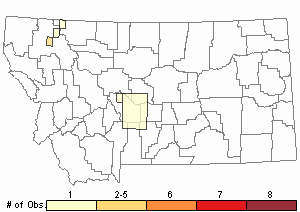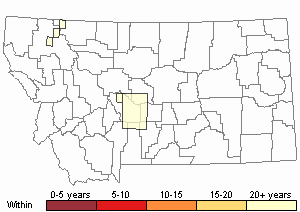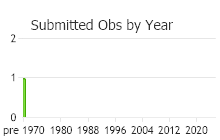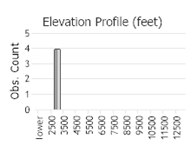View in other NatureServe Network Field Guides
NatureServe
Montana
Utah
Wyoming
Idaho
Wisconsin
British Columbia
South Carolina
Yukon
California
New York
A Dry Rock Moss - Grimmia elatior
Other Names:
A Black Rock Moss
General Description
Plants: Acrocarpous. Growing in fragile, uncrowded clumps of erect shoots (FNA 2007) or mats, green with yellow tones (Lawton 1971) to deep or blackish green above (FNA 2007), brown or black proximally. Stems frequently forked (Lawton 1971), 1-5 cm long; no central strand present (FNA 2007).
Leaves: Overlapping (Lawton 1971) and holding lightly near to the stem or a little spiraled when dry, spreading somewhat when wet (FNA 2007), strongly folded longitudinally above (Lawton 1971), 2-3 mm in length, 0.5-0.7 mm in width, lance-shaped, sometimes with ovate tendencies (FNA 2007) with a broad base (Smith 1980), narrowing to an acute leaf tip (FNA 2007) with a hair-point; hair-point smooth or slightly and finely toothed, 0.3-0.8 mm in length (Lawton 1971), sometimes up to half the length of the lamina (Smith 1980); margins widely curved and rolled outward and under along one edge; costa convex (FNA 2007) and occasionally somewhat ridged on the dorsal side (Lawton 1971), disappearing in the apex (Smith 1980).
Leaf Cells: Margins generally more than 2 cell-layers thick; lamina of 2 cell layers above, with conspicuous several-layered bands; distal cells isodiametric or irregular; with thick walls somewhat wavy and sometimes slightly papillose; middle laminal cells wavy and larger than the upper cells (Lawton 1971), square to short and quadrangular, with thick walls; basal laminal cells adjacent to the costa quadrangular, long to short, with thick walls ranging from weakly to strongly wavy (FNA 2007), the basal margins with shorter to square cells in several rows, the cells not transparent (FNA 2007; Lawton 1971).
Diagnostic Characteristics
Most plants in North America do not have papillae although the species is described as having them (FNA 2007).
Grimmia leibergii is frequently confused for G. elatior. However, G. leibergii has recurved leaf edges on both sides rather than just on one side, and its lamina is all of 1 cell layer (only the margins have 2 layers) rather than of 2 layers above with several-layered bands (FNA 2007).
Range Comments
North American Range
YT, BC and AB, OR, MT s to CO, SD, and NJ; common in the northern Rocky Mountains (FNA 2007). Known in Montana from Cascade, Flathead, Glacier, and Meagher Counties (Elliott 2016).
Observations in Montana Natural Heritage Program Database
Number of Observations: 10
(Click on the following maps and charts to see full sized version)
Map Help and Descriptions
Relative Density

Recency



 (Observations spanning multiple months or years are excluded from time charts)
(Observations spanning multiple months or years are excluded from time charts)
Habitat
Dry, usually acidic rocks in open areas. Elevation: 1640-14,760 feet (FNA 2007).
Reproductive Characteristics
Dioicous. Fruit somewhat infrequently produced. Seta 2-3 mm tall, bowed. Capsule partially or entirely raised above the perichaetial leaves, brown, with small ridges; peristome teeth divided above, purple, bearing papillae (FNA 2007).
Stewardship Responsibility
References
- Literature Cited AboveLegend:
 View Online Publication
View Online Publication Elliott, J.C. and A.K. Pipp. 2018. A Checklist of Montana Mosses (1880-2018). Updated 3 January, 2020. Montana Natural Heritage Program, Helena, Montana. 73 pp.
Elliott, J.C. and A.K. Pipp. 2018. A Checklist of Montana Mosses (1880-2018). Updated 3 January, 2020. Montana Natural Heritage Program, Helena, Montana. 73 pp. Flora of North America Editorial Committee, eds. 2007. Flora of North America North of Mexico. Volume 27. Bryophytes: Mosses, Part 1. Oxford University Press, Inc., NY. xxi + 713 pp.
Flora of North America Editorial Committee, eds. 2007. Flora of North America North of Mexico. Volume 27. Bryophytes: Mosses, Part 1. Oxford University Press, Inc., NY. xxi + 713 pp. Lawton, E. 1971. Moss Flora of the Pacific Northwest. Hattori Botanical Laboratory. Japan: Yamabuki-cho, Shinjuku-ku, Tokyo. 362 pages plus appendices.
Lawton, E. 1971. Moss Flora of the Pacific Northwest. Hattori Botanical Laboratory. Japan: Yamabuki-cho, Shinjuku-ku, Tokyo. 362 pages plus appendices. Smith, A.J.E. 1980. The Moss Flora of Britain and Ireland. Cambridge University Press, Cambridge. 705 pp.
Smith, A.J.E. 1980. The Moss Flora of Britain and Ireland. Cambridge University Press, Cambridge. 705 pp.
- Additional ReferencesLegend:
 View Online Publication
View Online Publication
Do you know of a citation we're missing? Elliot, J. C. 1993. Second checklist of Montana mosses. Unpublished report. U.S. Forest Service, Region 1. Missoula, MT. 45 pp.
Elliot, J. C. 1993. Second checklist of Montana mosses. Unpublished report. U.S. Forest Service, Region 1. Missoula, MT. 45 pp. Lawton, E. 1971. Keys for the Identification of the Mosses on the Pacific Northwest. Reprinted from 'Moss Flora of the Pacific Northwest'. Published as Supplement No. 2 of the Journal of the Hattori Botanical Laboratory. Nichinan, Miyazaki, Japan. 66 pp.
Lawton, E. 1971. Keys for the Identification of the Mosses on the Pacific Northwest. Reprinted from 'Moss Flora of the Pacific Northwest'. Published as Supplement No. 2 of the Journal of the Hattori Botanical Laboratory. Nichinan, Miyazaki, Japan. 66 pp.
- Web Search Engines for Articles on "A Dry Rock Moss"





